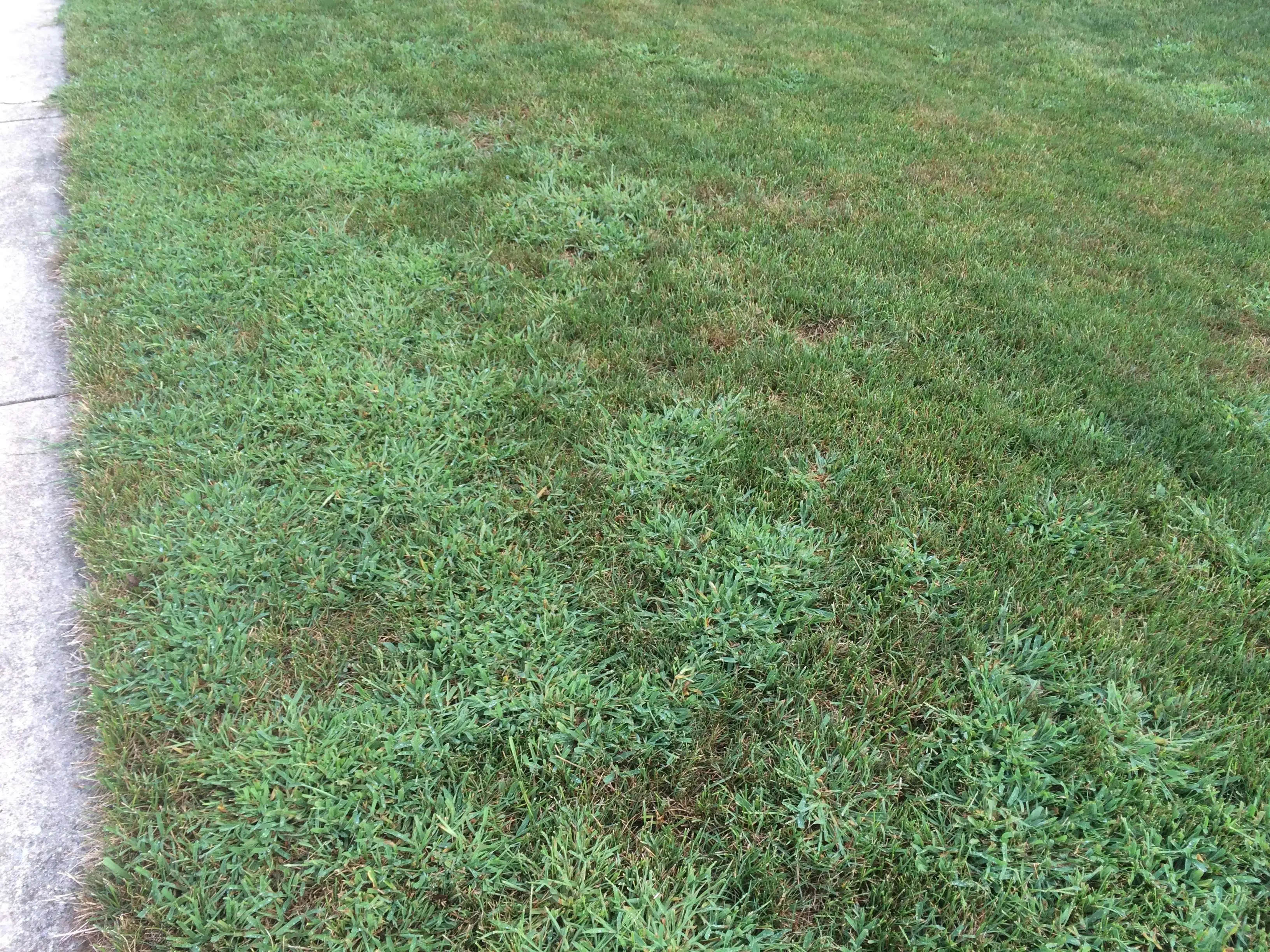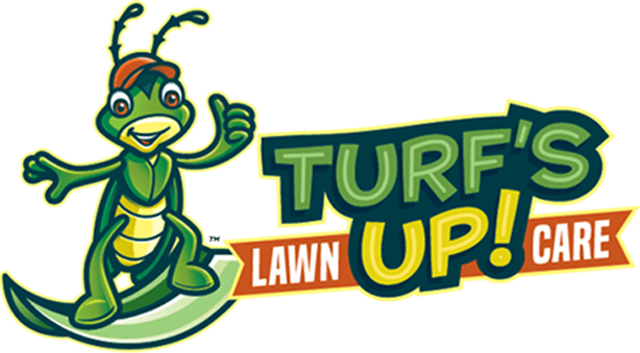It can be incredibly frustrating to be left wondering “what’s wrong with my lawn?” and not be able to get to the bottom of it. You may have even tried a variety of different remedies but might be seeing no success.
You’re not alone. Lawn care is more complicated than most people realize. Getting to the bottom of exactly what your issue is, and how to address it, requires some investigating and research.
While there are many different lawn problems that homeowners struggle with, dead patches, poor color, thinning areas, and tough weeds are four of the most common. We will explore each of these problems, as well as what may be causing them, and talk about how to fix them.
1. Dead Patches
Dead patches are a common lawn problem that can become a major source of frustration. There are a number of reasons why you might be seeing them. These include the following.
Turf Disease
Patches of brown and dying grass are commonly caused by disease. For instance, fungal diseases such as Brown Patch or Dollar Spot thrive in moist conditions and can spread easily (even walking on it can spread it).  If left untreated, these types of diseases can eventually cause permanently dead spots.
If left untreated, these types of diseases can eventually cause permanently dead spots.
While some fungal diseases are due to temporary environmental conditions and will resolve themselves when the weather changes, a bad case of turf disease may require treatment in the form of fungicides.
Of course, the absolute best way to address these sorts of lawn problems is preventative maintenance. A healthy and thriving lawn will resist disease and bounce back quicker from minor problems.
Insects Feeding on Lawns
 Insects, such as grubs (which are the larvae of beetles, like the Japanese beetle) and chinch bugs, can also cause dead patches.
Insects, such as grubs (which are the larvae of beetles, like the Japanese beetle) and chinch bugs, can also cause dead patches.
Grubs damage your lawn by eating the roots and leaving nothing to hold the grass down. If it gets bad enough, your lawn will actually be able to roll up like a carpet.
To address a grub problem, you’ll first need to get the grubs under control with the application of a professional product. Once you have dealt with the grub infestation, you’ll need to reseed or sod your lawn to replace the damaged areas.
Again, the best defense is proactive care. Using a preventative grub control treatment on your lawn will prevent grubs in the first place.
Chinch bugs, on the other hand, use their mouth parts to essentially suck the life out of your grass blades. If you have a chinch bug problem, curative treatment will be necessary. However, preventative applications are also a good approach to keep the damage from ever happening.
Drought Stress on Lawns
 Lawns require around one to two inches of water per week, either naturally through rainfall or via watering. If you notice your lawn turning brown and dying, it’s possible that it may not be receiving enough water. Compacted areas of your lawn are more prone to drought damage. As a result, a healthy and thriving lawn will be able to withstand drought conditions better than an already-struggling lawn.
Lawns require around one to two inches of water per week, either naturally through rainfall or via watering. If you notice your lawn turning brown and dying, it’s possible that it may not be receiving enough water. Compacted areas of your lawn are more prone to drought damage. As a result, a healthy and thriving lawn will be able to withstand drought conditions better than an already-struggling lawn.
Just be careful to tread cautiously when it comes to assuming your lawn is experiencing drought. Of the various lawn problems that could cause dead spots, a lot of homeowners automatically assume a brown or dying lawn needs more water. But if it turns out it was actually due to a fungal disease, water is only going to exacerbate your problem.
Excessive Water on Lawns
On the flip side, a lot of homeowners don’t think about the fact that too much water can also be bad for their lawn. When you overwater a lawn, you risk drowning it. This happens when the water replaces the air in the soil, taking away its access to oxygen. This will lead to brown patches and ultimately may kill your lawn.

Signs that you’ve overwatered include a lawn that “squishes” when you walk on it, has runoff onto your hardscaped areas, may develop of fungal diseases, or even begins to wilt. The problem with the latter is that a lot of homeowners assume the wilted grass is under watered and they water even more. This only makes the lawn worse. The solution requires cutting back on your watering habits and correcting grading if possible. Aerating your lawn each year can help in some cases, as well.
Poor Soil
It’s also possible that your lawn problems are related to the health of your soil. Clay-like, compacted soil can cause the overall health of your lawn to decline and can even lead to bare spots.
If you have poor soil conditions, you’ll want to have aeration and overseeding performed in order to break up the compaction and improve the structure of the soil in order to allow more water, sunlight, and nutrients to percolate down to the roots.

Immediately after aeration and overseeding, topdressing the lawn with compost will also help improve your soil. As the compost mixes with the clay, it helps create a better layer of topsoil by improving soil structure and microbial life.
Chemical Damage
If spilled or applied incorrectly, chemicals such as herbicides or pesticides can also cause dead spots on your lawn. Even fertilizer, if applied incorrectly, can burn the grass. If taking a DIY approach to chemical applications, it’s vitally important that you follow application directions, handle products with care, and store them properly. Your diligence in this matter will prevent chemical damage to your lawn.
Of course, lawn care products are not the only chemicals that may wind up on your lawn. Gasoline, chemicals from your pool, road salt, and other contaminants can also make it onto your lawn and cause severe damage.
If you do accidentally spill a product or somehow get a chemical on your lawn, completely soak the area with a hose. Unfortunately, even when taking immediate action, there may still be damage. If it does lead to a bare spot, replacing the soil and then following up with seeding or sodding will be necessary.
2. Poor Grass Color
Whether your grass isn’t as green as you want it to be or perhaps it’s greener in some areas than other, you might be getting frustrated about the overall look of your lawn. Before fixing a lawn that has poor color, you must get to the root of what’s causing these lawn problems.
Soil pH of Lawn
In order for your lawn to thrive, it must have the proper pH balance for the species of grass that is growing. A soil test will reveal what your lawn needs in order to bring the pH to the proper level.
Not Watering Your Lawn Enough
The absence of water can also cause your lawn to be lackluster in color. A drought-stricken lawn will go brown as it goes dormant and can eventually die if not remedied. Water is the obvious solution to bring back the vibrancy to your lawn.

Of course, just as we mentioned previously, too much water can also be a culprit. If you are overwatering your lawn, you risk depriving it of oxygen. As a result, the lawn will start turning yellow, may wilt, and will eventually turn brown, and may die. Overwatering also leaves your lawn more prone to diseases, which can also affect the color.
Grass Type
If you’re seeing different shades of green pop up throughout the lawn, this is likely an issue of grass type. For instance, if you did some spot repair and put down grass seed that doesn’t match the rest of your lawn, this could be one reason for the variation.
Some may also be naturally occurring or invasive species that were minimal in the past but due to changes in weather are now way more noticeable (particularly during certain times of the year). Some examples include Orchardgrass, Bentgrass, and Rough Bluegrass.

Sometimes it’s also an issue of having contractor’s grade grass seed put down. These mixes are fast-growing and tend to be resilient, which is why it’s often used when a home is first built. But it’s also a blend and tends to have a lot of filler, many of which may be weeds or invasive grass species. This is another common reason for grass that is lacking consistent color.
Lack of Lawn Care Services
Poor grass color might also be due to the fact that your lawn hasn’t received vital lawn care services that would allow it to thrive. Services such as topdressing, aeration, and overseeding can make a world of difference in the overall health and appearance of your lawn.
3. A Thin Lawn
A thinned out lawn is another one of the common lawn problems homeowners are frustrated by. After all, you want a lawn that is thick and thriving, not a lawn that looks thin and bare. If you’re fixing a lawn that has a thin appearance, it may be one of these common culprits.
Shade
The areas of your lawn that fall in shady areas can be thinned out or bare. Even if you’re using a shade-tolerant grass variety, it’s still going to require at least five hours of direct sunlight to survive and thrive.

The best solution for filling in shady thinned out areas is to get those spots more sunlight. By pruning your trees you might be able to allow more sunlight to filter in and reach your grass.
If the area is still too shaded, grass simply may not be an option. If this is the case, you may need to talk to a landscape designer to come up with another solution. Adding hardscaped areas or even extending the mulch areas around your trees are possible solutions.
Insect or Disease
Just as insect or disease damage can cause some of the other lawn problems we’ve talked about, it can definitely cause thinning, as well. If you have an infestation of insects or disease that affects a certain grass type in your lawn then it may thin out those specific areas.
The first step to address thinning as a result of insect or disease is to identify the culprit. Since different diseases and insects require different treatments, it’s important that you correctly identify what you’re dealing with.
Poor Soil
If your grass is thinning, it may be a result of low soil pH. Most grasses prefer a soil environment that is slightly acidic. A soil test will determine whether your lawn problems are a result of poor soil health.
Not Enough Fertilizer
Fertilization is an important lawn care service which provides your lawn with essential nutrients. It’s important to maintain an ideal nutrient ratio of nitrogen, phosphorus, and potassium in your lawn. Failing to fertilize your lawn often enough will cause thinning as it suffers from nutrient deficiencies.
Mowing Too Short
Grass thinning can also occur when you cut your lawn too short. Removing too much of the grass blade can reduce photosynthesis and affect energy production and growth. Cutting your lawn too short also exposes it to excessive sunlight. In our region, we recommend a cut height of around 3 ½ to 4 inches.
4. Tough Weeds
All weeds are a nuisance but when it comes to tough-to-control weeds, the solution can be such a mystery that you are left pulling your hair out. Identifying weeds in your lawn is the first step to knowing how to control them. Some of the following weeds are the most-difficult-to-control in our region.
Wild Violets
Because it has such a resilient root system, wild violet is a hardy weed that is difficult to control. Its leaves have a waxy coating that makes it difficult for weed control products to stick.
While certain products will knock back wild violet, a long-term strategy requires multiple rounds of spraying, possibly even for multiple years. In addition, thickening up your lawn will also help it to naturally defend against the spread of wild violets.
Ground Ivy
This low-growing perennial weed is an aggressive member of the mint family. Ground Ivy is one of the most difficult to control weeds in a lawn because it spreads by seeds and stolons (stems which grow at the soil surface or just below ground).
It requires a liquid, selective, post-emergent broadleaf weed control application during its period of active growth. This may require repeated applications over a multi-year period.
Nutsedge
Nutsedge is a perennial weed that can be difficult to get rid of. This grassy weed, also sometimes called “nutgrass,” has yellow-greenish leaves with a spiky yellow flower.

Though referred to as a “grass,” nutsedge is not actually a grass or a broadleaf. Therefore, it must be controlled with specially formulated products and may require multiple rounds of application each season. It will come back in at least some capacity each year, so be sure to make nutsedge control part of an ongoing lawn care program.
Grassy Weeds
Invasive grasses such as wild onion or garlic, and crabgrass are incredibly frustrating to deal with. Wild onion and garlic may die off on its own as the summer heats up but the underground bulb will continue to persist for years. However, treatments with herbicide can help them to visibly wilt and repeated efforts will help with reduction each year.
Similarly, crabgrass is an annual grassy weed that is also tricky to get rid of. Due to the fact that it spreads so rapidly, crabgrass will grow in thick and unattractive clumps throughout the yard (particularly in thinned-out areas). It is best controlled with pre-emergent applications to prevent crabgrass from germinating as well as post-emergent to control breakthroughs.
Invasive grasses can be aggressive and while you may have had some creep in and not even realize it at first, over time, and with certain weather conditions, they can really begin to take over.
If you’re noticing different patches of green throughout your lawn then you may have invasive or undesirable grass species. Sometimes there is no remedy other than to apply non selective weed control product and then renovate the entire area. Fortunately, that’s usually extreme. Many grassy weeds can be gotten under control without a total renovation.
Solving Lawn Problems with Professional Lawn Care Services
While some of these lawn care problems can be dealt with on your own, the truth is that nothing beats having the professional experience and knowledge that comes with hiring professional lawn care services in Ashburn, Aldie, or Leesburg, VA.
The biggest benefit of working with a professional is that they’re going to know what’s actually wrong with your lawn. Rather than guessing, and possibly addressing the issue improperly, they’ll get started with the correct solution right away.
This is important as the wrong treatment can actually make your lawn worse. For instance, watering a lawn that has a fungal disease is going to make that disease spread even more rapidly.
Or, you might be prolonging a serious problem while you try different solutions. For instance, if you have a grub infestation, there is really no time to lose. You need to get your lawn treated immediately. If you waste time while trying various other solutions, your lawn could be destroyed.
Choosing Wisely
Unless you have a background in lawn care, you are probably uncertain of what your lawn truly needs. But instead of having to spend any more time puzzling over how to fix these frustrating lawn problems, you can choose to hand those worries over to a lawn care expert, who knows what your lawn needs.
By choosing to work with a lawn care company that has your best interest at heart, you’ll get to the root of your lawn problems and have an expert who is ready to handle them for you. That means you get to spend more time using your lawn for enjoyment and less time worrying about what’s wrong with it.
If you want to solve your puzzling lawn problems at your Ashburn, Aldie, or Leesburg, VA home, talk to an expert, choose a solution, and then enjoy your yard and relax.
Image Sources: dead grass, grubs, puddle,browning lawn, shady lawn, ground ivy, nutsedge



